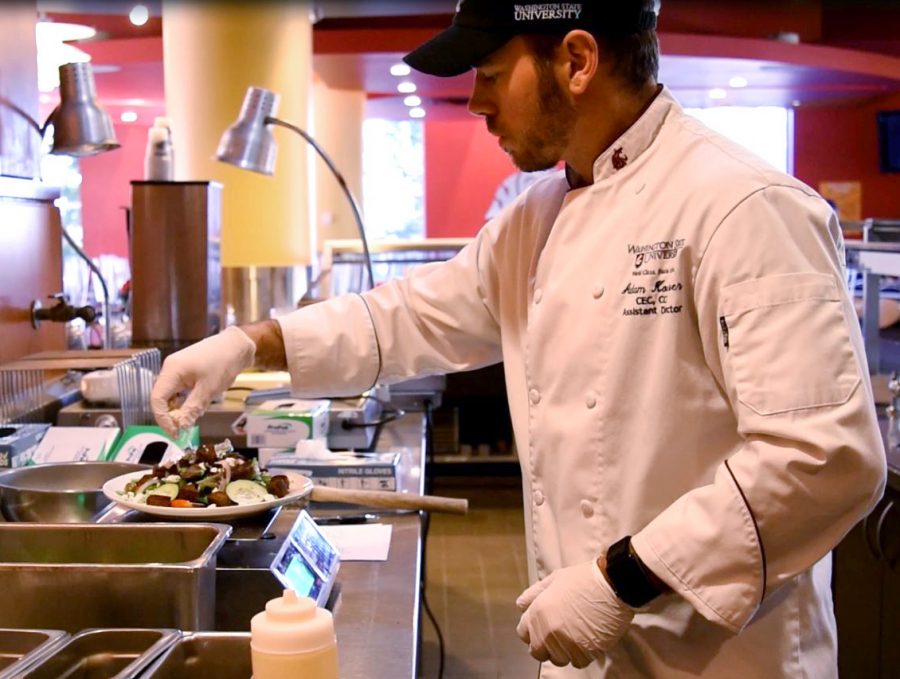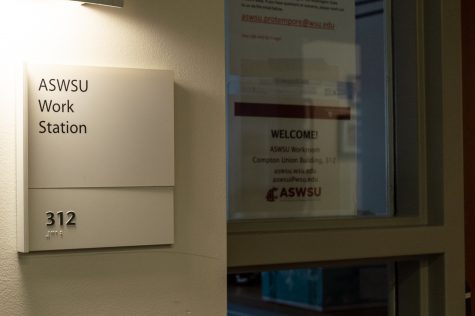Chefs keep up on trending recipes
Dining Services test kitchen averages 10 new recipes per week
LATISHA JENSEN | The Daily Evergreen
Adam Koerner, assistant director of culinary operations, compiles a Greek salad in the testing kitchen to weigh the final product in hope of putting it in the dining halls
December 8, 2017
The aroma of spices and veggies filled the air as campus chefs sautéed freshly chopped ingredients in the Northside Dining Hall test kitchen.
In one day, they tested three recipes: green chickpea curry, a Greek salad with lemon tahini sauce and smashed green chickpea avocado salad.
Green chickpeas are the new item they’re trying to incorporate more. They are like chickpeas but picked prior to peak ripeness and processed differently.
Chris Siple, WSU Dining Services sous chef, was the first sous chef hired when the university decided to add this position in May 2016. It is dedicated to testing recipes before they enter the dining halls. Before, he served about four years as a Dining Services chef.
Similar to most other chefs on campus, Siple keeps up with popular recipes and trends. But for this job in the test kitchen, it is crucial to know what people are eating.
New to him are plant-based diets. Meat adds a lot of flavor to food, so when cooking with mainly vegetables, pulling flavor from them is essential to create a tasty dish, Siple said.
“It’s pretty fascinating. Plant-based … isn’t how I eat,” Siple said, “or I guess didn’t. I’m starting to get toward that more.”
Adam Koerner, assistant director of culinary operations, also partly works in the testing kitchen with Siple and is proud of how the kitchen develops meals to keep up with a changing society.
“We try to bring our strengths to the table based on what they want,” Koerner said. “It’s driven by students with a lot of different perspective.”
They expect Falafel croutons to be the next food added to salad bars across campus as a different form of protein, he said.
Keeping up with society
Siple likes cooking with solely vegetables because it allows for creativity and he has to think outside of the box.
“When I was in school, it was just burgers, pizza,” he said. “You couldn’t get away with serving vegan food back then, but now people are more conscious. It’s challenging.”
If there is a simple substitution that makes a recipe more allergen friendly, like using olive oil instead of butter, that’s an easy change for them to make, Koerner said.
Other trends besides plant-based foods include authentic international dishes, street-style food like smaller plate items, and unusual products like the green chickpeas, he said.
Koerner is most proud of the “Grab n’ Go Bites” program, which launched this fall. Instead of five or six-day-old veggies and ready-to-eat meals like before, they are now prepared fresh every morning and the shelf life doesn’t go beyond three days.
This process from start to finish took a full year, which Koerner said is good timing.
“The quality is there, the value is there and we can control the freshness,” he said. “It was a fun process.”
When it comes to international foods, finding those flavors can be a challenge, he said. There is a push for authenticity instead of just utilizing those particular flavor profiles.
Alice Ma, WSU Dining Services dietician, said they’ve looked at authentic recipes written by people from those cultures.
They’ve tested international breakfast options like Kimchi toast and rice, she said.
“Not everyone has eggs or bacon or toast for breakfast,” Ma said. “When you’re from another country, those aren’t things you’re used to.”
Trial and error
Items like the Kimchi toast aren’t always as big a hit as they expect, Ma said.
“We will see something that we like,” she said, “and sometimes you never know if students are going to love it, or absolutely hate it.”
If a recipe turns out in the testing kitchen, it is first added to a complex database, Siple said. They weigh and measure the volume of each ingredient as well as the final product and enter it in. This ensures portions are correct, so when converted from a household serving size to thousands, they have enough supplies, Siple said.
Koerner said on average, about 10 dishes are tested each week, and it can take weeks, or even months, until students and customers see these dishes in the dining halls.
It’s also important to cross-utilize food products, he said, to minimize waste and find a balance of costs, nutrition and sustainability initiatives.
Siple said they test food multiple times if they don’t work out on the first try.
“It will work in the test environment and our chefs will be like, ‘Hey this didn’t work.’ Can we try doing this?’ ” Siple said. “We don’t give up on anything, especially if it’s something we want to serve.”
Their cauliflower wings, for example, were tested a few times because at first it was just like eating a piece of cauliflower. Then the flour they used made the texture gritty. But eventually, they got the texture and flavor how they wanted, Siple said.
They also try to bring in students and staff to taste-test and see if they would buy their creations, he said.
Generating ideas with criticism
Koerner enjoys the challenge of creating food for a diverse population and playing around with interesting recipes, like their falafel waffle, that could be used to substitute things like a bun for a slider.
“Food is my tool,” Koerner said. “When I get a good reaction, that makes my day. When I get a bad reaction, it makes me work harder next time.”
Koerner wishes they could roll recipes out quicker than they do, but this is necessary for them to achieve their goals and remain consistent.
As a vegan, Ma has received mostly positive feedback and appreciation from student vegans about the increasing variety of food they can eat.
“Having things like cauliflower wings, [plant-based] pancakes and mac ‘n’ cheese, things we’ve never seen in the dining centers, it’s opened a lot of doors,” Ma said. “I like seeing the final product come out and then seeing what the feedback is.”






















